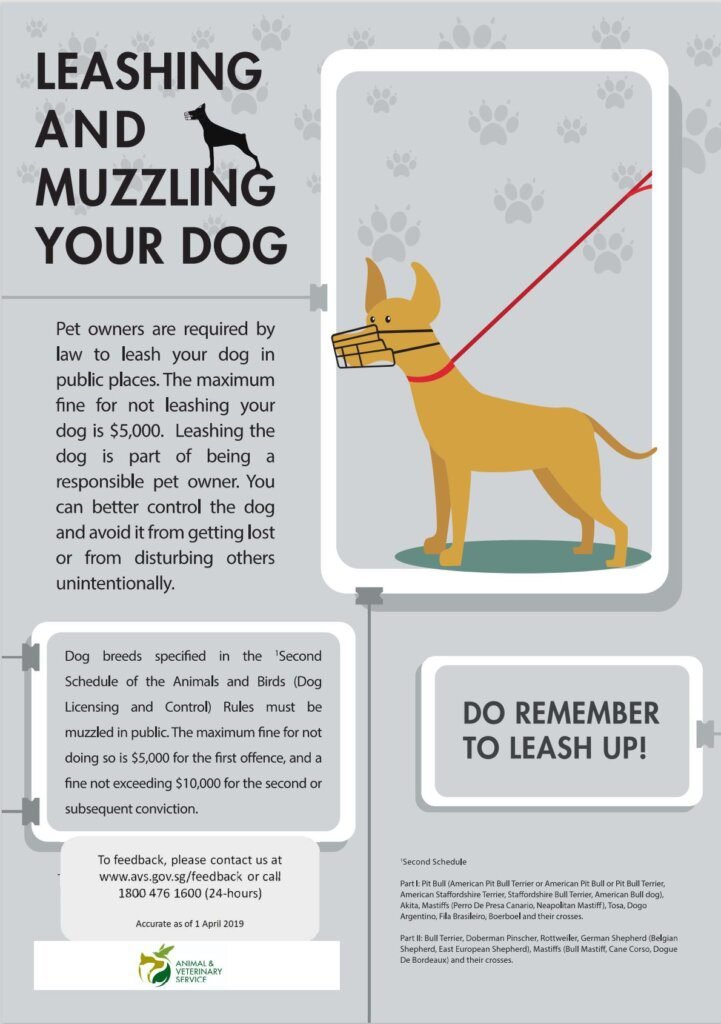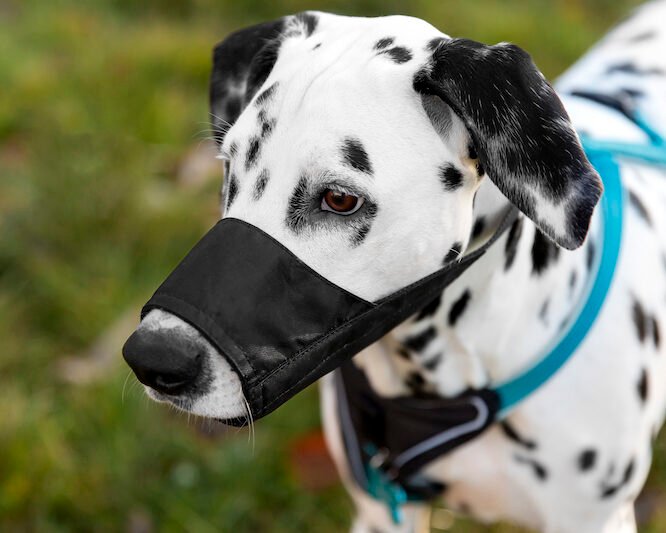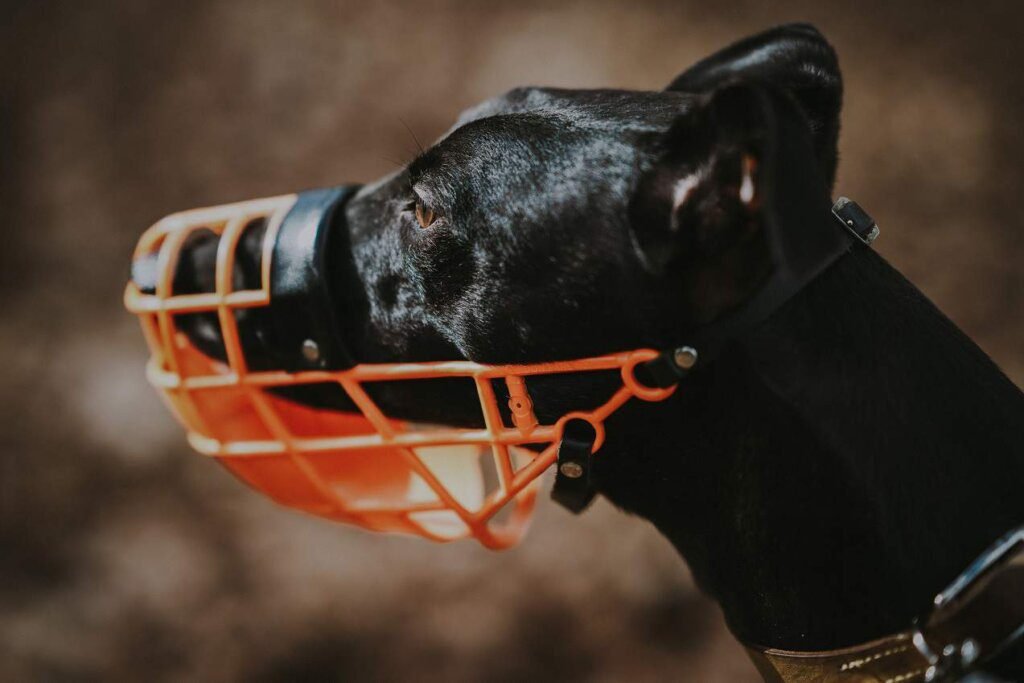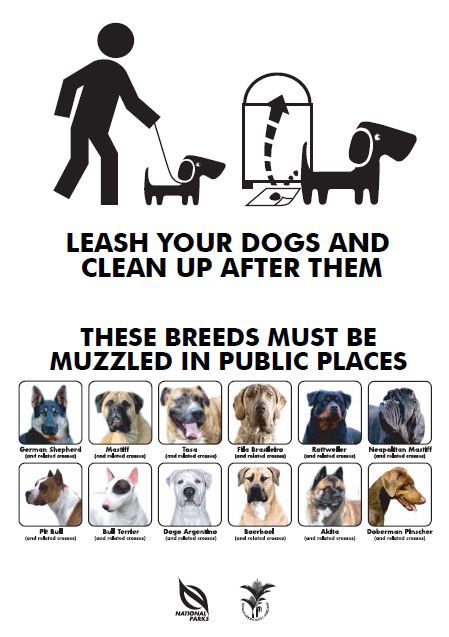Table of Contents
Dog owners in Singapore may find themselves in a situation where they may need to muzzle their furry friends. Understanding the guidelines for muzzling dogs in Singapore is crucial to ensure the safety and well-being of both your dog and the people around you. Whether it be due to aggressive behavior, fear-based reactions, or other reasons, these guidelines aim to provide valuable information on when and how to properly use a muzzle. By following these guidelines, you can confidently navigate the responsibilities of owning a muzzled dog while ensuring a harmonious coexistence in the vibrant streets of Singapore.
When is Muzzling Required
Muzzling is a practice that is required in certain situations to ensure the safety of the dog and the people around them. In Singapore, there are specific guidelines on when muzzling is necessary for dogs. These guidelines primarily focus on public spaces, public transportation, and veterinary clinics.
Public Spaces
In public spaces such as parks, sidewalks, and shopping areas, dogs that are deemed as potentially aggressive or dangerous are required to wear a muzzle. This is to prevent any possible incidents or harm to other individuals or animals. The muzzle acts as a safety measure, ensuring that the dog cannot bite or harm others if they were to become aggressive.
Public Transportation
When traveling on public transportation, dogs are also required to be muzzled. This is to ensure the comfort and safety of other passengers and to prevent any potential incidents during the journey. Muzzling a dog on public transportation can provide peace of mind to both the owner and the other passengers, allowing everyone to travel in a secure and stress-free manner.
Veterinary Clinics
In veterinary clinics, muzzling is often required to ensure the safety of the veterinary staff and other animals in the clinic. Dogs that are in pain or distress may act aggressively, even towards those trying to help them. By muzzling the dog, the veterinary staff can perform necessary procedures and examinations without the risk of injury to themselves or other animals.
Choosing the Right Muzzle
When it comes to choosing a muzzle for your dog, it’s essential to select the right type and ensure a proper fit that prioritizes comfort and safety. There are different types of muzzles available in the market, such as wire basket muzzles, plastic basket muzzles, and fabric muzzles.
Types of Muzzles
Wire basket muzzles are a popular choice as they allow for better airflow and a wider range of motion for the dog’s mouth. They have a more secure fit and are suitable for dogs with a longer snout. Plastic basket muzzles are lightweight and easier to clean but may not fit all dogs properly. Fabric muzzles, on the other hand, are more flexible and suitable for dogs with a shorter snout.
Proper Fit
Regardless of the type of muzzle chosen, it is crucial to ensure a proper fit. The muzzle should allow the dog to pant and drink water comfortably. It should fit snugly but not be overly tight, avoiding any potential discomfort or restriction of movement. Taking accurate measurements of your dog’s snout is important to ensure the muzzle fits properly and serves its purpose effectively.
Comfort and Safety
Comfort and safety should be the top considerations when choosing a muzzle. Look for muzzles with padded straps or ones made from softer materials to increase comfort for your dog. It’s also essential to choose a muzzle that allows the dog to open its mouth to a certain extent, enabling them to pant and cool down in warm weather. Prioritizing comfort and safety ensures a positive experience for both the dog and its owner.
Training and Acclimating the Dog
Introducing a dog to a muzzle can be a gradual process. It is important to make the experience positive for the dog through positive reinforcement, gradual introduction, and consulting a professional trainer if needed.
Positive Reinforcement
Using positive reinforcement techniques can help associate the muzzle with positive experiences for the dog. Start by offering treats and rewards whenever the dog interacts with the muzzle, reinforcing the association between the muzzle and positive outcomes. Gradually progress to fastening the muzzle while providing treats and praise, creating a positive association between wearing the muzzle and receiving rewards.
Gradual Introduction
To ensure a dog is comfortable with wearing a muzzle, it is important to introduce it gradually. Begin by allowing the dog to sniff and explore the muzzle without actually putting it on. This helps the dog become familiar with the object and reduces any potential fear or apprehension. Slowly progress to placing the muzzle on the dog for short periods, gradually increasing the duration as the dog becomes more accustomed to it.
Consulting a Professional Trainer
If you are unsure about how to properly introduce a muzzle to your dog or if your dog shows signs of fear or anxiety, consulting a professional trainer can be beneficial. Trainers can provide guidance on the best approach for training your dog to wear a muzzle and addressing any concerns or challenges that may arise during the process. They can tailor their advice to your dog’s specific needs, ensuring a successful and positive training experience.
Ensuring Proper Usage of Muzzles
Once a dog is accustomed to wearing a muzzle, it is crucial to ensure its proper usage to maintain the safety and well-being of both the dog and those around them. This involves supervision and monitoring, regular cleaning, and replacing worn-out muzzles.
Supervision and Monitoring
Whenever a dog is wearing a muzzle, it is essential to closely supervise and monitor their behavior. Keep an eye out for any signs of distress, discomfort, or irritation. Dogs should never be left unattended while wearing a muzzle, as it can pose a potential safety risk. Regular checks and observations can help identify any issues early on and ensure the dog’s comfort and safety.
Regular Cleaning
Keeping the muzzle clean is essential to prevent the buildup of bacteria or unpleasant odors. Muzzles should be cleaned regularly using mild soap and water or specialized pet-friendly cleaning products. Pay close attention to any hard-to-reach areas or crevices where dirt or debris may accumulate. A clean muzzle not only promotes good hygiene but also increases the dog’s comfort while wearing it.
Replacing Worn-out Muzzles
Due to regular usage, wear and tear can occur on muzzles over time. It is important to regularly check for any signs of damage or deterioration and replace worn-out muzzles promptly. A damaged or ill-fitting muzzle may not provide adequate protection or comfort for the dog, compromising their well-being and the purpose of using a muzzle. Regularly inspecting and replacing muzzles as needed ensures their effectiveness and ensures the safety of everyone involved.

Legal Requirements and Penalties
Muzzling requirements in Singapore are enforced to maintain public safety and prevent potential incidents involving dogs. Familiarizing yourself with the legal regulations, penalties for non-compliance, as well as any exceptions or exemptions is crucial to ensure you comply with the law.
Muzzle Regulations
Muzzle requirements may vary depending on the specific circumstances and locations in Singapore. It is important to understand the relevant regulations and guidelines that apply to your situation. Consult the Agri-Food & Veterinary Authority of Singapore (AVA) or local government websites for accurate and up-to-date information on specific muzzle regulations.
Penalties for Non-Compliance
Failure to comply with muzzle regulations can result in penalties, including fines and legal consequences. These penalties are in place to deter non-compliance and ensure the responsible ownership and handling of dogs. By understanding and adhering to the regulations, you can avoid unnecessary trouble and ensure the safety of your dog and others.
Exceptions and Exemptions
In certain situations, there may be exceptions or exemptions to muzzle requirements. These exceptions are typically granted based on specific circumstances, such as dogs undergoing training or dogs with medical conditions that make wearing a muzzle impractical or harmful. It is important to consult the relevant authorities or seek professional advice to determine if your dog qualifies for any exceptions or exemptions.
Risks and Limitations of Muzzling
While muzzling can be an effective safety measure in certain situations, it’s important to be aware of the potential risks and limitations associated with using a muzzle.
Potential Discomfort and Stress
Wearing a muzzle can cause discomfort and stress for some dogs, especially if they are not properly trained or acclimated to wearing one. Dogs may find it challenging to pant, drink, or communicate with other dogs while wearing a muzzle. It is crucial to regularly assess your dog’s comfort level and provide breaks from wearing the muzzle when appropriate.
Inhibiting Natural Behaviors
Muzzles restrict a dog’s ability to bark, bite, eat certain objects, and engage in other natural behaviors. While this may be necessary for safety reasons, it is important to remember that muzzling should only be used when required and not as a permanent solution. Recognizing when a situation requires the use of a muzzle and seeking alternatives when possible is crucial for a dog’s overall well-being.
Seeking Alternatives
While muzzling may be necessary in certain situations, seeking alternatives whenever possible is important. This could include addressing any underlying behavioral issues through proper training and socialization, using positive reinforcement techniques, or seeking professional help from trainers or behaviorists. Exploring other options allows for a more holistic approach to managing a dog’s behavior and ensuring a safer and happier environment for everyone involved.

Addressing Misconceptions about Muzzling
There are several misconceptions surrounding muzzling, which can lead to misunderstandings and negative stereotypes. Familiarizing ourselves with the truth can help address these misconceptions and promote a better understanding of why and when muzzling is necessary.
Muzzling as a Sign of Aggression
One common misconception is that muzzling a dog automatically means they are aggressive or dangerous. However, this is not always the case. Many dogs may be required to wear a muzzle due to specific regulations or to mitigate potential risks. It is important to remember that muzzling is a proactive safety measure and not a reflection of a dog’s temperament or behavior.
Muzzling as a Permanent Solution
Another misconception is that muzzling is a permanent solution to behavioral issues. Muzzling should be seen as a temporary measure and should be accompanied by proper training and behavior management techniques. A muzzle alone cannot address the underlying causes of aggression or other behavioral issues. Understanding this helps promote responsible ownership and ensures the appropriate and effective use of muzzles.
Resources for Dog Owners
For dog owners in Singapore, various resources and services are available to support responsible ownership and provide assistance when it comes to muzzling and other aspects of dog care.
Muzzle Retailers and Brands
There are numerous retailers and brands in Singapore that specialize in dog muzzles, offering a wide range of options to suit different dog breeds and sizes. These retailers can provide expert advice and guidance in choosing the most appropriate muzzle for your dog’s needs.
Dog Training Schools
Dog training schools and obedience classes can provide valuable guidance and support in training your dog and addressing any behavioral concerns. Trainers can help create a positive and safe environment for both you and your dog, ensuring effective training methods and promoting responsible ownership.
Dog-Friendly Spaces in Singapore
Singapore offers a variety of dog-friendly spaces where dogs can exercise, socialize, and interact with other dogs and their owners. These spaces provide opportunities for dogs and their owners to engage in training, exercise, and play in a safe and controlled environment. Familiarizing yourself with these dog-friendly spaces can greatly contribute to a positive and fulfilling experience for both you and your dog.

Promoting Responsible Dog Ownership
Muzzling is just one aspect of responsible dog ownership. To maintain the well-being of your dog and ensure a harmonious coexistence with the community, there are several other important factors to consider.
Regular Veterinary Check-ups
Regular veterinary check-ups are essential for your dog’s overall health and well-being. These check-ups allow for early detection of any potential health issues and ensure that your dog is up to date with vaccinations and preventive treatments. Consulting with your veterinarian and following their advice is crucial for maintaining your dog’s optimal health.
Socialization and Obedience Training
Proper socialization and obedience training are key elements of responsible dog ownership. Socializing your dog with other dogs, animals, and people from a young age helps them become well-adjusted and confident. Obedience training establishes a foundation of good behavior and ensures that your dog can respond to commands, enhancing their safety and allowing for more enjoyable interactions with others.
Understanding and Meeting the Dog’s Needs
Understanding and meeting your dog’s physical, mental, and emotional needs is vital for their overall well-being. Providing a balanced diet, regular exercise, mental stimulation, and affectionate care are essential. Each dog has unique needs, and taking the time to understand and fulfill these needs ensures a happy and healthy life for your furry friend.
Conclusion
Muzzling dogs in certain situations, such as in public spaces, public transportation, and veterinary clinics, is necessary to ensure the safety of both the dogs and the people around them. Choosing the right muzzle, training and acclimating the dog, and ensuring the proper usage of muzzles are important steps in ensuring a positive and safe experience for everyone involved. Familiarizing yourself with the legal requirements and penalties, understanding the risks and limitations of muzzling, and addressing misconceptions promote responsible dog ownership. By utilizing available resources for dog owners and implementing a holistic approach to dog care, we can create a community that prioritizes the well-being and safety of our furry companions.





